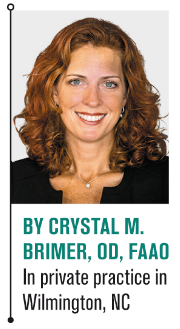Surviving allergy season as a contact lens wearer
Depending on where you live, spring is here-or at least on its way. It’s the time of year to thaw out along with the trees, grass, and flowers. With spring comes our promise to get ourselves into shape for the summer, and life gets busier with more outdoor activities for the whole family.


Depending on where you live, spring is here-or at least on its way. It’s the time of year to thaw out along with the trees, grass, and flowers. With spring comes our promise to get ourselves into shape for the summer, and life gets busier with more outdoor activities for the whole family.
This creates a conundrum.
Though it is the time of year that inspires both new and established contact lens wearers to get into their lenses, it’s also the time of year that seems to cause the most detriment to contact lens wearers.
Previously from Dr. Brimer: How to establish value in the minds of contact lens wearers
Identify and educate
Patients with allergies do not always experience itch, so our first obligation is to actively look for ocular surface signs that help identify allergy. Look for papillae, allergic mucous, filmy tears, and contact lens buildup-or reduced lens wettability.
Osmolarity and immunoglobulin E (IgE) testing come in handy as well, and both are reimbursable. If the patient is not itching or is resistant to comply, use your anterior segment camera to show them what you see. Anterior segment camera imaging is an effective tool to convince patients to use a medication, change contact lenses, or adjust their lifestyle habits.
Related: Using tinted contact lenses in practice
Treat aggressively
The first thing I stress is for patients to flush their eyes with eye wash or preservative-free tears before and after contact lens wear. This will dilute any allergic mucous, debris, or inflammatory proteins in the tears-and lessen the likelihood of it ending up on the contact lens.
Next, I ask them to use an allergy drop before contact lens application. Though you may have a favorite, familiarize yourself with all the newer medicines available because prescribing an allergy drop has become a much tougher task than one would expect. We receive several calls and faxes per day denying a particular allergy drop due to insurance coverage.
Ask your staff to help create a cheat sheet of local formulary preferences to help reduce your allergy Rx denials.
Related: How to keep athletes’ eyes healthy in contact lenses
Allergy drops
Pazeo (olopatadine 0.7%, Alcon) and Lastacaft (alcaftadine, Allergan) have convenient once-daily dosing. Pataday (olopatadine, Alcon) is the 0.2% version of Pazeo and is still indicated for once-a-day use, while Patanol (0.1% olopatadine, Alcon) and Bepreve (1.5% bepotastine besilate, Bausch + Lomb) are both twice-a-day use. These are convenient options for contact lens wearers-no midday dosing required.
However, if a patient has extreme allergies I may use Alrex 0.2% (loteprednol etabonate, Bausch + Lomb) instead or in addition to another allergy drop. In this case, I ask the patient to remove his contact lenses midday and rinse with preservative-free tears before instilling the drop into his eye.
I reserve Alrex and midday dosing for patients who are quite symptomatic-even in daily disposables-and who need to significantly reduce their wear time for added control. For patients somewhere in between, I ask them to flush their eyes with a contact lens rewetting drop, while wearing their contact lenses, at least once during the day.
Related: How diabetes affects contact lens wear
Daily disposables
We would certainly prefer that our allergy patients wear a daily disposable contact lens, but convincing them is sometimes another story. I’m surprised by the number of patients I see who are in minimal-to-great discomfort and have admitted to hearing about daily disposables from their previous eye doctors.
Not only did they resist the advice, but they ended up seeking care elsewhere. Perhaps our presentation skills for daily disposables could be honed-and allergy season is the perfect opportunity to do so.
I find that more patients agree to daily disposables during allergy season, so use this time to dive in and perfect your presentation to the patient. Discuss what you’re seeing while seated behind the slit lamp with him.
Focus the discussion on the health of the ocular surface and his current exposure to potential consequences. Be adamant. Be persuasive. Use external photos for added conviction.
Build your confidence through consistent prescribing during the next few months, and offer daily disposables to every contact lens patient you see.
Prepare for success by stocking up on the number of daily disposable samples in your trial room, and coach staff on how to support you in your endeavor. The greatest benefit will be to your patients, and your confidence will continue to grow as you see how much better they feel during this critical time of year.
Like you, I have patients who are resistant due to cost or because their exact power is not available in a daily disposable lens. I advise these patients to at least buy a 90-pack for each eye to wear during allergy season.
When properly educated, many are willing to sacrifice the extra money or some clarity to be more comfortable. I also find that those who thought they were too expensive typically return the next year asking to wear daily disposables year round.

Allergy season provides the perfect opportunity to convert your contact lens wearers into a daily disposable modality. But if patients must remain in a reusable contact lens, be careful to fit them in a lens with a surface treatment or material known for better build up resistance.
Related: Contact lenses and dry eye: Cause or remedy?
Peroxide-based cleaners
For anyone with allergies whose prescription is out of range for daily disposables, I am adamant that a peroxide-based cleaner be used year round-not just during allergy season.
PeroxiClear (Bausch + Lomb) and Clear Care Plus (Alcon) are my first choices. I have found that patients can typically feel and see a significant difference when they are compliant with a thorough cleaning regime.
Related: Low-cost contact lens site looks to improve compliance, drive exams
Lifestyle
A patient’s lifestyle habits influence his allergen exposure-beginning with his wearing habits. I always ask my allergy patients to count how many hours they are wearing their contact lenses per day, then I limit it by at least three hours from their normal wear time. If they are in a reusable contact lens, I ask them to discard it at least 25 percent earlier than they usually do.
This means that during allergy season, patients throw out their monthly lenses at three weeks instead of one month. Patients may or may not comply with this request, but at least they will think twice regarding overextending their reusable lenses.
Prevention
Here’s where things can become more complicated, but where you can really help patients take better control of their allergies. I ask patients to shower at night instead of in the morning. We would be shocked to see the allergens-and other disgusting things -we pick up on a normal basis during any given day.
The last thing we want to do is deposit these things on our pillows at night and proceed to smear our faces in it-repeatedly. In fact, I advise them to go one step further and change their pillow cases every night. Sheets should be changed approximately every three nights during the height of allergy season.
Be sure allergy patients wear sunglasses to shield their eyes while outside and try to avoid windy conditions. Use of artificial tears before and after time outdoors can also help. It may seem obvious, but if the car is green when it’s usually black-stay inside!
Unfortunately, patients may have indoor allergies as well. These patients still flare up from seasonal allergies because they are compounded on top of their chronic allergies.
Patients allergic to dust should wear a dust mask when cleaning-or better yet, hire someone.
Related: Embracing new contact lens technology
Promote awareness
I always know when allergy season starts, because the patient complaints become more abundant and more consistent.
Depending on your location, allergies can be a big problem for your patients. The more contact lens patients you have, the more allergic complaints you are likely to hear, but it can provide a chance to deliver a timely clinical as well as marketing message.
Consider using Constant Contact or other online email marketing service to send a “Prepare for Allergy Season” flyer to all your patients. Also, have patient education materials available in the office.
With the symptoms being intermittent, sometimes patients refrain from complaining or simply forget. Any time you can help patients with symptomatic relief-big or small-it influences their satisfaction and inspires loyalty.
Newsletter
Want more insights like this? Subscribe to Optometry Times and get clinical pearls and practice tips delivered straight to your inbox.